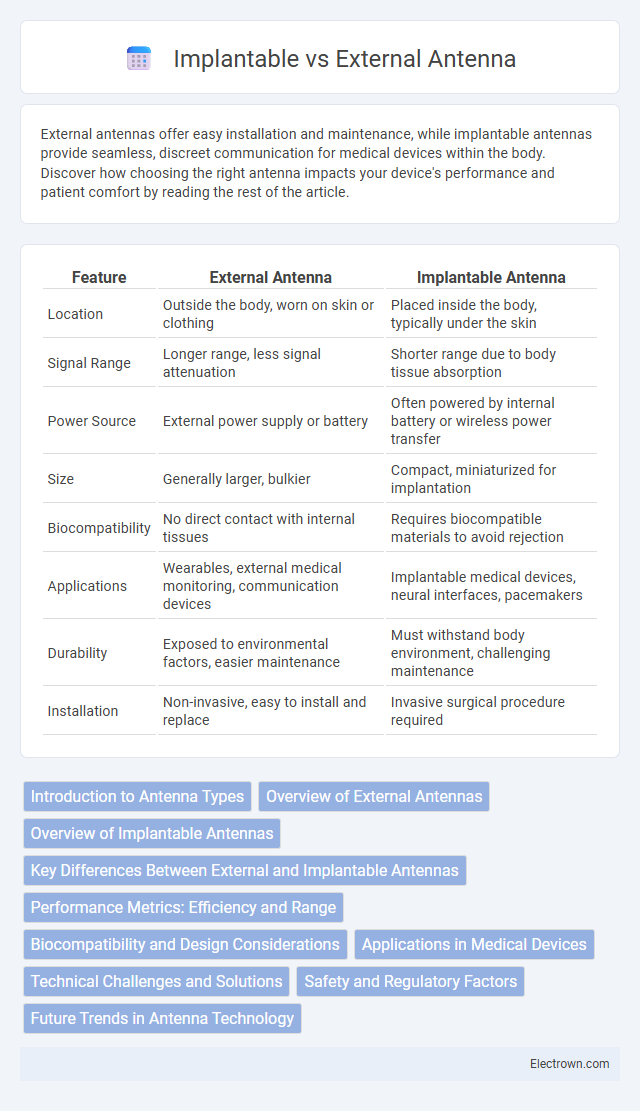External antennas offer easy installation and maintenance, while implantable antennas provide seamless, discreet communication for medical devices within the body. Discover how choosing the right antenna impacts your device's performance and patient comfort by reading the rest of the article.
Table of Comparison
| Feature | External Antenna | Implantable Antenna |
|---|---|---|
| Location | Outside the body, worn on skin or clothing | Placed inside the body, typically under the skin |
| Signal Range | Longer range, less signal attenuation | Shorter range due to body tissue absorption |
| Power Source | External power supply or battery | Often powered by internal battery or wireless power transfer |
| Size | Generally larger, bulkier | Compact, miniaturized for implantation |
| Biocompatibility | No direct contact with internal tissues | Requires biocompatible materials to avoid rejection |
| Applications | Wearables, external medical monitoring, communication devices | Implantable medical devices, neural interfaces, pacemakers |
| Durability | Exposed to environmental factors, easier maintenance | Must withstand body environment, challenging maintenance |
| Installation | Non-invasive, easy to install and replace | Invasive surgical procedure required |
Introduction to Antenna Types
External antennas are typically mounted outside a device, offering easy installation and maintenance while providing robust signal reception for applications like GPS and cellular communication. Implantable antennas, used primarily in medical devices, are designed for biocompatibility and miniaturization to enable reliable wireless communication within the human body. Both antenna types differ significantly in materials, size, and operational environment to optimize performance for their specific use cases.
Overview of External Antennas
External antennas are devices mounted outside a device or on its surface to enhance signal reception and transmission, commonly used in wireless communication systems like radios, GPS, and IoT devices. They provide higher gain and better spatial coverage compared to implantable antennas, making them ideal for applications requiring long-range connectivity and stronger signal strength. Your choice of an external antenna impacts overall device performance, especially in environments needing robust and reliable wireless communication.
Overview of Implantable Antennas
Implantable antennas are specialized devices designed to operate efficiently within the human body, enabling wireless communication for medical implants such as pacemakers, neural stimulators, and biosensors. These antennas must overcome challenges like signal attenuation caused by biological tissues and comply with strict biocompatibility and miniaturization requirements to ensure safe, long-term functionality. Your choice of an implantable antenna directly impacts the reliability and performance of critical healthcare monitoring and therapeutic systems.
Key Differences Between External and Implantable Antennas
External antennas are typically larger, designed for easy access and adjustment outside the body, providing higher transmission power and better signal range compared to implantable antennas. Implantable antennas, however, are miniaturized and biocompatible, engineered to operate efficiently within the harsh, conductive environment of human tissues while minimizing energy consumption. Understanding these key differences helps optimize Your device's performance and safety in medical or wearable applications.
Performance Metrics: Efficiency and Range
External antennas generally offer higher efficiency and extended range due to their larger size and ability to be optimally positioned, reducing signal attenuation and improving transmission quality. Implantable antennas face constraints in size and surrounding biological tissue, which absorb and scatter signals, leading to lower efficiency and limited range. Advanced materials and design innovations are being developed to enhance implantable antenna performance by optimizing impedance matching and minimizing tissue-induced losses.
Biocompatibility and Design Considerations
Implantable antennas require biocompatible materials such as medical-grade silicone or Parylene-C to ensure safety and prevent tissue reaction, whereas external antennas have fewer biocompatibility constraints. Design considerations for implantable antennas prioritize miniaturization, flexibility, and stable performance within the body's lossy dielectric environment, while external antennas focus on maximizing range and bandwidth in free space. Your choice between these antenna types depends on application-specific factors like implantation depth, signal attenuation, and long-term biostability.
Applications in Medical Devices
External antennas in medical devices offer non-invasive communication options ideal for short-term monitoring and diagnostics, while implantable antennas provide continuous, reliable connectivity crucial for long-term health management such as pacemakers or insulin pumps. Implantable antennas are designed with biocompatible materials to minimize immune response and optimize signal transmission within the body's complex environment. You should consider the specific medical application's duration, signal requirements, and implantation constraints when choosing between external and implantable antenna solutions.
Technical Challenges and Solutions
External antennas face challenges like signal attenuation and physical obstruction, limiting their reliability in wearable and mobile devices. Implantable antennas must overcome biocompatibility, miniaturization, and tissue absorption effects, requiring advanced materials and adaptive designs to maintain effective communication. Your device's performance improves with solutions such as flexible substrates, impedance matching techniques, and frequency tuning to address environmental variability and energy constraints.
Safety and Regulatory Factors
External antennas are generally subject to fewer regulatory hurdles since they do not require implantation and can be easily removed or adjusted, minimizing long-term safety concerns. Implantable antennas must comply with strict biocompatibility standards and rigorous testing to ensure they do not cause tissue damage, infection, or adverse immune responses. Your choice should consider these safety and regulatory factors to ensure compliance with medical device regulations and patient well-being.
Future Trends in Antenna Technology
Future trends in antenna technology emphasize miniaturization, increased bandwidth, and enhanced integration with IoT devices for both external and implantable antennas. Advances in metamaterials and bio-compatible materials accelerate the development of implantable antennas with improved signal stability and biocompatibility. External antennas are evolving towards adaptive beamforming and multi-frequency capabilities to support next-generation wireless communication standards like 5G and beyond.
External vs Implantable Antenna Infographic

 electrown.com
electrown.com